Scare Tactics: There's Nothing Like a Good Ghost Story
There’s nothing like a good ghost story to grab kids’ attention

Illustration by Mark Todd
There’s no doubt about it—paranormal fiction is hot right now. Our shelves are full of vampires and werewolves, faeries and zombies—and get ready for an incoming wave of fallen angels! As a fan of all things supernatural, I’m thrilled about this explosion of the immortal, the unknown, and the mythological. And yet, it feels like we’re missing the eternal constant in this renaissance: ghosts.
Oh, they’re still there—hazy at the edges, slipping in and out of sight like a mirage, and maybe that’s just their nature. But I’d like you to turn, ever so slowly, so you can catch a glimpse of some of the great spectral stories that are out there. Ghosts can be monsters or heroes, funny or morose. They can be our friends and our sweethearts, and, in some cases, they might be more human than the human beings they haunt. Here are a handful of my favorite titles—some old, some new—all flickering with the light of a story well-haunted, the perfect thing for restless tweens and teens.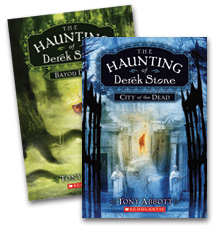 The Haunting of Derek Stone: City of the Dead and Bayou Dogs
The Haunting of Derek Stone: City of the Dead and Bayou Dogs
Abbott, Tony. Scholastic, 2009. Don’t be fooled by the brevity of these novels. Derek Stone’s story is dark and surprisingly intense. Abandoned by his mother, Derek somehow survives a freak train accident that kills his remaining family. After the crash, he’s haunted by the voices of the dead, and when his late brother reappears, it’s clear that something supernatural is afoot. City of the Dead (book one of “The Haunting of Derek Stone” series) concerns itself with world building. The real action starts in book two, Bayou Dogs, when Derek is on the run from angry ghosts that have been set loose among the living. Abbott has put some serious thought into understanding the divide between life and death, mixing physics and metaphysics with ease. It’s a scientific-minded approach that still subscribes to a horror point of view, a novelty that I savored. 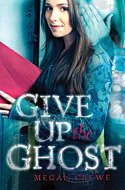 Give Up the Ghost
Give Up the Ghost
Crewe, Megan. Holt, 2009. It’s not uncommon for ghosts to have needs, but this time around it’s the humans who need to be put to rest. Cass McKenna has been able to see ghosts ever since her older sister died. An outcast, Cass spends her time collecting gossip from ghosts—a potential weapon in her war against the popular kids. When her class VP comes undone after his mother’s death, Cass has to decide whether to help him—and whether it’s time to give up the companionship she finds with her sister’s lingering spirit. I love that twist, and this book is wonderfully readable. I started the first chapter at bedtime, and suddenly it was midnight as I turned the last page. 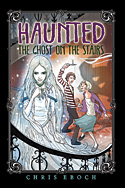 Haunted: The Ghost on the Stairs
Haunted: The Ghost on the Stairs
Eboch, Chris. S & S/Aladdin, 2009. Like Ghost Huntress (see below), this is a thoroughly modern take on tweens in spectral jep. Thirteen-year-old Jon and 11-year-old Tania don’t just stumble into the presence of ghosts. They’re taken there by their mother and stepfather, who produce and star in a paranormal reality show reminiscent of the popular television series Ghost Hunters. There’s a lot of gadgeteering in this story, but it’s really about siblings from a broken home who are thrust into a strange situation—and what happens when one of them starts seeing the other side. Touches of humor (like a real ghost’s annoyance with the TV show’s fake medium) save the story from becoming maudlin. And Jon narrates with an authentic, skeptical voice, which makes the resolution to their haunting problem unexpectedly creepy. 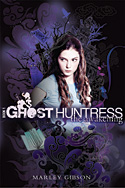 Ghost Huntress: The Awakening
Ghost Huntress: The Awakening
Gibson, Marley. Houghton/Graphia, 2009. With a contemporary setting and a conversational voice, the “Ghost Huntress” series will shatter any old-fashioned expectations you have about ghost stories. Sixteen-year-old Kendall may be a standard-issue new girl, but her school, Radisson High, has a Gossip Girl flavor, right down to its bulimic cheerleaders. The school geek trades in electromagnetic field readers, spectral voices come through white-noise machines, and these teen investigators record EVP (electronic voice phenomena). Kendall’s inability to summon not just a phantasm but also proof of its existence plays a major part in the story. Nimbly escapist, this series captures the 21st-century approach to paranormal phenomena: out with the mediums, and in with the orbs and miniDV. I love how now this is! 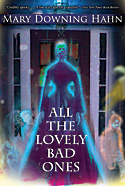 All the Lovely Bad Ones
All the Lovely Bad Ones
Hahn, Mary Downing. Clarion, 2008. Hahn has made a career out of creating terrific ghost stories, but I picked this one because it’s not often that the protagonists are the naughty ones. Travis and Corey are so badly behaved that their mother sends them to spend the summer at their grandmother’s spooky Vermont inn. Left with limited entertainment options, these troublemakers decide to act out ghost stories and pull some pranks on the inn’s guests. When the devious duo unexpectedly attracts the attention of some real ghosts, chaos ensues. Hahn balances the chills nicely with playful humor. This is a great ghost story if you like to be scared… but not too scared.  ghostgirl
ghostgirl
Hurley, Tonya. Little, Brown, 2008. From the glass coffin on the cover to the silver-edged pages and ornate Victorian lettering and illustrations, ghostgirl sets a mood. But it’s not sepulchral—this book is a 100 percent, black-clad fairy tale. Although Charlotte User choked to death on a gummy bear, she refuses to abandon her quest to become one of Hawthorne High’s most popular girls. What follows is a whimsical, Tim Burton–esque recounting of Charlotte’s struggles to cling to her past life, when she should probably just learn to accept her new supernatural one. Everything about this book is clever—it’s a delight to look at, a pleasure to hold, and a treat to read. I look forward to future installments. 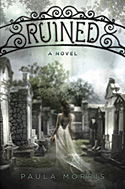 Ruined
Ruined
Morris, Paula. Point, 2009. Ruined touches on all the classic ghost story staples: curses, an unmarked grave, a seemingly friendly spirit leading the heroine into dangerous territory. What’s special about this story are its glimpses into real-life New Orleans: the city’s complicated, multicultural past and present, the unique flavor of some of its neighborhoods (which are among our nation’s oldest), and the realities of this delta harbor after Hurricane Katrina. Morris doesn’t stint on the ugliness in the Big Easy’s past, but she also celebrates its remarkable beauties—in a story that runs through carnival season like a perfect string of beads. 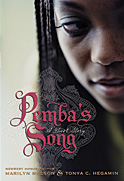 Pemba’s Song: A Ghost Story
Pemba’s Song: A Ghost Story
Nelson, Marilyn and Tonya C. Hegamin. Scholastic, 2008. When her overprotective mother moves from Brooklyn to Connecticut, 14-year-old Pemba is bummed: she misses her city, her friends, and her boyfriend, Malik. The only things left in her life are her music and the lyrics she writes in a notebook. But not long after Pemba arrives in her new home, she finds herself lost in strange daydreams—and discovers that Phyllys, the ghost of an 18th-century slave, is peering out at her from the mirror. Caught up in a centuries-old mystery, Pemba can’t stop reaching back to the eerie voice, even though it unsettles everyone around her. The dreaminess of this novel is palpable, and the voices so clarion that I often found myself flipping pages back to read another snippet of Pemba’s lyrics or get one more glimpse of Phyllys’s life as a New England slave. 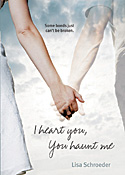 I Heart You, You Haunt Me
I Heart You, You Haunt Me
Schroeder, Lisa. Simon Pulse, 2008. When Ava’s boyfriend, Jackson, dies during a foolish dare, she’s devastated. Ava has lost her first true love... and then he comes back. Another haunting tale written to help make sense of death’s senselessness, I Heart You, You Haunt Me casts a quiet circle around the reader. Schroeder’s verse is silken, and it runs deep. When the late Jackson reappears, you can almost taste the frost on the mirror. And later, when Ava realizes that it’s time to move on with her life, her aching grief slips off the pages and into the reader’s bones. This is a great companion to Pemba’s Song, which also uses verse in a dynamic way, revealing the very human heart in these unearthly stories. 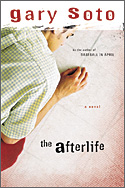 The Afterlife
The Afterlife
Soto, Gary. Houghton, 2003. When the main character is murdered on page four, everything that follows could have been relentlessly bleak. Instead, 17-year-old Chuy Chavez slips into his afterlife with gentle humor and grace. He observes everything—from the pennies he stole from his grandfather to a fire he accidentally set with one of his friends to the girls he never kissed and the ghosts he’s newly met. Though Chuy is recently deceased, this is very much a coming-of-age story, and with sentences like “She floated up the steps and, by my side, entered the den of nickel-and-dime thieves,” I find myself savoring this tale’s language again and again. 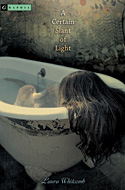 A Certain Slant of Light
A Certain Slant of Light
Whitcomb, Laura. Houghton/Graphia, 2005. When I think of ghosts in literature, the first title that comes to mind is A Certain Slant of Light. Whitcomb’s story of a young woman who’s technically alive but dead inside and Helen, a ghost who slips into her host’s skin after 130 years of formless grief, has a quiet fierceness to it. Plus, the story isn’t afraid to tackle some of life’s big questions: What’s the value of a life unlived? How can we forgive ourselves for seemingly unforgivable acts? These questions are threaded into the fabric of an unlikely romance between Helen and a living boy, which gives this novel a contemporary, yet timeless, air. 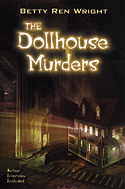 The Dollhouse Murders
The Dollhouse Murders
Wright, Betty Ren. Holiday House, 1983. Still as thrilling today as when it debuted more than 25 years ago, The Dollhouse Murders is the quintessential ghost story. It has a tween protagonist, Amy, who visits an unfamiliar home, with an unfamiliar older relative. It has an attic that’s full of secrets and haunted artifacts that long to reveal those secrets. The story is so vivid that, even now, years later, I can close my eyes and see the dolls moving in the dollhouse at night, restaging the murder of Amy’s grandparents. Although this book may be aimed at middle-school readers, its sneaky, creepy power is sure to appeal to teens, too. Sometimes I’m in the mood for a taste of ghost, just a little something spooky to linger when I turn out the lights. That’s when I turn to anthologies. Dead Man’s Gold and Other Stories (Groundwood, 2002) by Paul Yee mingles the history of Chinese immigrants in North America with the ghost stories they brought with them. Betsy Hearne’s Hauntings: And Other Tales of Danger, Love, and Sometimes Loss (HarperCollins/Greenwillow, 2007) is another well-rounded collection of stories with a tale to suit any whim. And no list of haunted fiction would be complete without Vivian Vande Velde, whose two-decade career is rich with spirits. Her anthology Being Dead and Other Stories (Harcourt, 2001) is wonderfully representative of her work. From fantastic to matter-of-fact, paranormal fiction is full of uneasy spirits. They may be quieter than the genre superstars. They may be harder to catch, but they’re there, I promise. So why not take a night off from dazzling vampires and dashing lycanthropes and give ghosts a try? You just might discover, like I have, that you want them to stay a little longer. In fact, you just might want them to stay… forever. Saundra Mitchell (saundra@saundramitchell.com) is the author of Shadowed Summer (Delacorte, 2009), a ghostly YA novel.
RELATED
RECOMMENDED
CAREERS
The job outlook in 2030: Librarians will be in demand
CAREERS
The job outlook in 2030: Librarians will be in demand
ALREADY A SUBSCRIBER? LOG IN
We are currently offering this content for free. Sign up now to activate your personal profile, where you can save articles for future viewing






Add Comment :-
Be the first reader to comment.
Comment Policy:
Comment should not be empty !!!